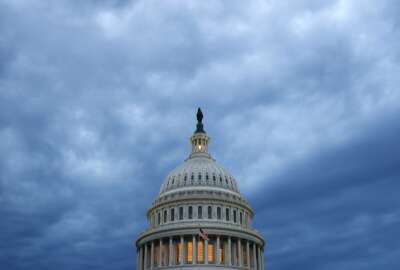
For a hybrid workforce, federal HR leaders look to improve hiring, retention
Human capital leaders at the Agriculture Department and the National Science Foundation are implementing new tools in an effort to improve both the recruitment...
In an effort to boost recruitment and retention for a now hybrid workforce, human capital leaders across agencies are thinking about different ways to enhance human resources systems and better support staff.
For hiring new employees, the National Science Foundation, for one, just began using the Office of Personnel Management’s talent acquisition system, called USA Staffing, earlier this month. The transition to the new system includes changes to the assessment of job candidates, a simplified interface for the candidate review process and more options for analyzing applicant data.
It’s not unique to the agency — many others across the government are implementing similar systems, but USA Staffing does allow for some customization options based on the individual agency. NSF Deputy Chief Human Capital Officer Bill Malyszka said the changeover is still in progress. The ultimate goal is to add more transparency to the hiring process and ease up some of the challenges for internal hiring managers.
“We’re trying to use our new talent acquisition system to remove the friction there, hopefully streamline that and find ways to not only get those digitized paper products in front of them, but hopefully also help remove some biases,” Malyszka said during a Feb. 23 FedInsider event. “We’re looking at opportunities to anonymize those applications, so that they’re looking at the qualifications of the candidates — not just using this to go from paper to digital, but also to improve how we conduct our processes and look at equity issues.”
Historically, agencies have used candidate self-assessments during the hiring process to determine whether or not a job applicant is qualified for an open position. But an executive order from 2020 urged agencies to expand their use of skills-based assessments when vetting candidates, and rely much less on self-assessments. The order also called for the creation of agency talent teams to help the process along.
“We’re looking at the whole hiring process,” Malyszka said.
For NSF, the agency’s talent team works with hiring managers to look more closely and objectively at candidates’ competencies and how they fit with a position’s requirements. One of the goals is to provide hiring managers with a higher-quality list of candidates.
Beyond changes to recruitment, for staff retention, NSF has a hybrid workforce evaluation program, which helps assess employees’ perceptions of remote work and telework opportunities. When employees leave the agency, NSF can look at qualitative data, like exit interviews, to understand the actual impact of remote work opportunities on workforce retention.
“What we’re trying to do is get to the evidence behind some of that, and in a manner so that we can react to it before we actually hit a tripwire and have a problem,” Malyszka said. “What does a candidate look like coming into those positions, if we don’t offer remote work? Are we seeing a big difference between us and maybe other agencies where they may offer more flexibility?”
Beyond collecting that data, Malyszka said other information can help better inform the process as well, including pulse surveys and listening sessions. For a smaller agency with just under 2,000 employees, it’s a little bit easier to manage the data, he added.
“We’re trying to get past the perception side of the employee experience data that gets collected and looking at also, what do the behaviors of our employees tell us? How they vote with their feet, where they want to work, how well they work, where their managers believe they are in terms of not only their engagement, but their performance,” Malyszka said. “We want to make sure whatever we’re doing is grounded in a real-world sense of what’s going on, and what we need to continue to be successful.”
Agriculture Department
In a larger department, the challenges of recruitment and retention for a hybrid workforce can look pretty different. The Agriculture Department, for one, is trying to find new methods to improve employee engagement, while navigating a geographically spread out workforce. Joseph Abbott, the chief human capital officer at USDA’s Food Safety and Inspection Service (FSIS), said that inclusion — part of the Biden administration’s diversity, equity, inclusion and accessibility initiative — is a significant component of employee engagement.
“To make the organization healthy, we’ve got to be inclusive,” Abbott said during the FedInsider event. “To get them [to feel] included, [employees] have to understand, see and hear what’s going on.”
As one way to try to improve inclusion, Abbott said the department created a digital weekly newsletter that in part highlights employees’ day-to-day work, across all types of jobs.
“We tell them about the mission, about how complex it is, the science part of food safety, as well as the inspection side — and the HR side and the IT side,” Abbott said. “They need to see that and actually recognize are human beings that are doing that.”
In another effort to build on employee engagement, the USDA administrator and other agency senior leaders regularly hold town halls to gather feedback from employees. FSIS also has employee awards, called recognition coins, that the administrator and other senior leaders give out to employees who “embrace engagement,” Abbott said. The awards include categories for employees who are collaborative, empowered or solutions-oriented, to name a few. And pulse surveys — short surveys that take a quick “pulse” on employees’ workplace perceptions — can additionally help HR managers get real-time feedback from staff.
Communicating regularly and early on in an employee’s career can help managers and other agency leaders avoid any surprises when an employee is getting ready to leave.
“We have employees with 50-plus years of service — I’ve got one who has had 60 years of service. And when those employees come to say, ‘I’m ready to finish my career,’ that’s not the time to find out something is missing,” Abbott said. “It’s important going forward that we capture and digitize that customer relations experience for the full lifecycle of their career.”
On the other side, that type of communication can also help retain an agency’s HR employees.
“Now they’re engaged in building something that’s going to get the rest of the workforce engaged. And that becomes an exponential force multiplier for us, because now my HR folks want to stay, and they want to see it through. They want to see the employee feedback when it works,” Abbott said.
Copyright © 2025 Federal News Network. All rights reserved. This website is not intended for users located within the European Economic Area.
Drew Friedman is a workforce, pay and benefits reporter for Federal News Network.
Follow @dfriedmanWFED





